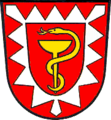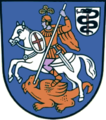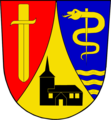Staff of Aesculapius
The Aesculapian staff or Asclepius staff is a staff wound around by a snake and is also known as the serpent staff . Originally it was an attribute of Asclepius (German: Äskulap), the god of medicine in Greek mythology . Today it is the symbol of the medical and pharmaceutical status.
Similar symbols are the Hermes staff in Greek mythology or the brazen serpent of Moses in the Old Testament . The Caduceus or Mercury staff is usually not a symbol that is used in medicine, but due to confusion, the Caduceus is used as a symbol in US medicine.
The Unicode symbol of the Aesculapius is u + 2695 ⚕ Staff of Aesculapius.
iconography
Asclepius
Asklepios (also called Aesculapius , after the Latin form of the name Aesculapius ) was the son of Apollon (god of light and healing) and the Thessalian princess Koronis . He was educated and trained in medicine by the healing Centaur Cheiron . Because as a doctor he raised the dead to life, he angered Hades, the ruler of the realm of the dead. At his insistence he was struck dead by Zeus with lightning because he had dared to oppose the will of the gods.
Asklepios was mostly depicted as a bearded man who leans on a stick around which a snake (adder) is wound.
The snake
Asklepios is said to have always had an Aesculapian snake with him during his lifetime, on hikes or on the way to the sick , which curled around his walking stick. Some depictions even show the worship of Asclepius himself in the form of a snake. Snakes were kept in the Greek temples of healing dedicated to the god Asclepius.
In many cultures around the world, snakes have been associated with gods (see symbolism and mythology of snakes ). The serpent has been an important mystical being since time immemorial; For example, in the epic epic of the same name, the god-king Gilgamesh steals the life-giving magic herb from a snake. In ancient times it finally became a symbol of medicine . Their characteristics “rejuvenation through molting”, “sharp-sightedness / vigilance” and “healing power” (pharmaceuticals were made from snake meat) made them a symbol of medical virtues and thus showed the advantages of medicine.
The rod
There are also many theories about the meaning of the stick. On the one hand, the staff is understood as a scepter or symbol of rule, other researchers believe that it is a simple walking staff that Asklepios always carried with him. Since it was seen as a connection between heaven and earth, the staff alone had magical powers.
Classical archaeologists point out that Asklepios leans on his staff in the same posture as the free citizen of the polis , who settles down to linger in the agora . Such representations can often be found on ancient grave stelae . In this and in the way in which he turns to people in images, Asklepios differs fundamentally from the representations of the Olympian gods .
But centuries before the Asclepius cults were described, there were reports of healings in connection with a snake on a staff: The brazen snake from the 4th book of Moses is considered to be the origin of the symbol.
The staff is a personal attribute of Asclepius. There are images of the Asclepius ritual (see below) with snakes but without a staff. Hygieia , the daughter of Asclepius, was depicted with a snake - without a staff.
Medina worm theory
One hypothesis for the origin of the symbol brings the staff of Aesculapius with in ancient times and still used practice to remove the Guinea worm ( Dracunculus medinensis ) combined. This worm, which is between 30 and 120 cm long, is in the last stage of its life cycle under the human skin and bores an opening to the outside through which it releases its larvae. To remove the worm, it is then wound on a split wooden stick, with a maximum of 10 cm being allowed to be wound up daily.
The worm hypothesis comes from the German hygienist Reiner Müller . However, there is no contemporary or early historical evidence to support the claim that it was originally a worm. Medina worms were known in ancient Egypt , but not in Greece. According to this hypothesis, the origin of the symbol would not be to be found in Greece.
A medina worm is about a millimeter thick. A snake like the one seen in the Asklepios depictions is about a hundred times greater in thickness, and its weight would be about 10,000 times greater. Correspondingly, the little sticks used to wind up the worm are much smaller than the stick of Asclepius, and the type of winding looks different (see illustration). The medical historian Bernd Grün believes with Erna Lesky that the Medinawurm hypothesis has been refuted.
history
The Asclepius ritual
The Asklepios ritual established itself from the 5th century BC. Until the end of antiquity to one of the most successful cults . The patients went to sleep in the temple of Asclepius, which was mostly outside of the city (see Enkoimesis ). Then in a dream the doctor appeared to them and recommended diets and other treatment methods for healing. Sometimes the patient was visited or bitten by a snake in a dream and thereby healed. The Sibylline books recommended on the occasion of an epidemic in 291 BC The cult transfer from Epidaurus to Rome , where the snake was depicted as a companion animal, helper and symbol. Here Asklepios got the Latin name Aesculapius .
Asclepios and Apollo as gods of healing
Asklepios differs from his father, Apollo, as a god of healing. In the cults of antiquity, the sick were not allowed to approach the sacred area of Apollo, but that of the demigod Asclepius. As a result, Apollo, the god of light, was increasingly associated with the concepts of divine remote healing, while Asklepios was associated with active therapeutic practice. Even in Roman times, the two cults were not in competition, Asklepios and Apollo as well as Salus were worshiped on the Tiber Island dedicated to Asklepios - during the plague epidemic of 180 BC. In Rome, for example, statues of all three healing gods were placed together. Later (from the 2nd century onwards) Telesphorus , the genius of recovery, was added to Asclepius .
But while the worship of the other two deities disappeared at the turn of the ages, the cult of Asclepius was preserved - in its symbolism to this day. The Apollonian aspect of the healing arts was taken up again by Paracelsus , but with him in a negative interpretation of mystical healing ("Appolinische Pfaffen").
heraldry
In heraldry (heraldry) the Aesculapian staff is depicted in family and communal coats of arms. The symbol is also used in the arms of the armed forces.
- Coat of arms of the city of Bad Nenndorf
- Coat of arms of the municipality of Karlsburg (Western Pomerania)
- Shield in shield , Rambin on Rügen
- Coat of arms of the municipality of Stuer
- Coat of arms of the former main medical depot Lorch-Rheingau of the Bundeswehr
literature
- Hans Schadewaldt : Aesculapian snake. In: Werner E. Gerabek , Bernhard D. Haage, Gundolf Keil , Wolfgang Wegner (eds.): Enzyklopädie Medizingeschichte. De Gruyter, Berlin / New York 2005, ISBN 3-11-015714-4 , p. 15 f.
Web links
- What does the Aesculapian staff symbolize? Interview with medical historian Bernd Grün, thieme.de, March 14, 2012
Individual evidence
- ^ Karl-Heinz Hunger: The Aesculapian staff. On the function of conservative symbols in communication. Spiess, Berlin 1978, ISBN 3-920889-76-2 .
- ↑ Gholamreza Darai, Michaela Handermann, Hans-Günther Sonntag, Lothar Zöller (ed.): Lexicon of infectious diseases of humans. Pathogen, symptoms, diagnosis, therapy and prophylaxis. Springer, Berlin / Heidelberg 2012, ISBN 978-3-642-17157-4 , p. 238.
- ↑ Werner E. Gerabek (Ed.): Encyclopedia of Medical History. de Gruyter, Berlin 2004, ISBN 3-11-015714-4 , p. 15.
- ↑ Erna Lesky: What is known about the original meaning of the snake staff? In: German Medical Weekly . Volume 84, 1959, p. 2095.
- ↑ What does the Aesculapian staff symbolize? Interview with Bernd Grün, thieme.de, March 14, 2012
- ↑ Aesculapius. In: imperiumromanum.com → Ancient Religion. Retrieved November 10, 2010 .
- ↑ Paracelsus . 9, 269, 25 (1531/35) In: Wilhelm Matthiessen, Karl Sudhoff: Complete works. 14 volumes, Barth, Munich 1922–, quoted from Karl-Heinz Weimann : Paracelsus and the German vocabulary. In: German word research in European references. Schmitz, Giessen 1963, p. 386.










